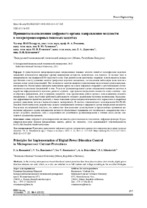| dc.contributor.author | Романюк, Ф. А. | |
| dc.contributor.author | Румянцев, В. Ю. | |
| dc.contributor.author | Румянцев, Ю. В. | |
| dc.contributor.author | Дерюгина, Е. А. | |
| dc.contributor.author | Климкович, П. И. | |
| dc.coverage.spatial | Минск | ru |
| dc.date.accessioned | 2023-08-10T07:42:35Z | |
| dc.date.available | 2023-08-10T07:42:35Z | |
| dc.date.issued | 2023 | |
| dc.identifier.citation | Принципы выполнения цифрового органа направления мощности в микропроцессорных токовых защитах = Principles for Implementation of Digital Power Direction Control in Microprocessor Current Protections / Ф. А. Романюк [и др.] // Наука и техника. – 2023. – № 4. – С. 317-325. | ru |
| dc.identifier.uri | https://rep.bntu.by/handle/data/133571 | |
| dc.description.abstract | В существующих микропроцессорных направленных токовых защитах линий от междуфазных коротких замыканий используются цифровые органы направления мощности, включаемые, как правило, на полные токи и напряжения по так называемой 90-градусной схеме. При данной схеме включения «мертвая» зона появляется только при близких к месту установки защиты трехфазных коротких замыканиях, составляющих небольшую долю всех возможных видов таких повреждений. Тем не менее ее наличие является существенным недостатком органов направления мощности. Рассмотрены принципы выполнения органа на основе цифровых операций с ортогональными составляющими подводимых напряжений и тока. Результат функционирования органа направления мощности сводится к выработке информационного признака, равного: единице – при прямом направлении мощности; минус единице – при ее обратном направлении. Для устранения «мертвой» зоны организована работа органа с использованием «памяти» напряжения. С целью получения требуемой длительности «памяти» реализована частотная компенсация. Исследование эффективности принятых решений, а также поведения органа направления мощности в нормальном и аварийных режимах выполнено методом вычислительного эксперимента. В системе динамического моделирования MATLABSimulink-SimPowerSystems разработаны модели электрической системы и цифрового органа направления мощности. Результаты исследований показали, что совместное использование существующих и предложенных принципов выполнения цифрового органа направления мощности обеспечивает повышение его технического совершенства и позволяет устранить «мертвую» зону с сохранением его устойчивого функционирования в течение сколь угодно длительного промежутка времени. | ru |
| dc.language.iso | ru | ru |
| dc.publisher | БНТУ | ru |
| dc.title | Принципы выполнения цифрового органа направления мощности в микропроцессорных токовых защитах | ru |
| dc.title.alternative | Principles for Implementation of Digital Power Direction Control in Microprocessor Current Protections | ru |
| dc.type | Article | ru |
| dc.identifier.doi | 10.21122/2227-1031-2023-22-4-317-325 | |
| local.description.annotation | In the existing microprocessor-based directional current protection lines from phase-to-phase short circuits, digital power direction elements are used, which, as a rule, are switched on at full currents and voltage according to the so-called 90-degree pattern. With this switching scheme, a “dead” zone appears only in case of three-phase short circuits close to the protection installation site, which make up a small fraction of all possible types of such damage. Nevertheless, its presence is a significant drawback of the power direction organs. The principles of organ execution based on digital operations with orthogonal components of input voltages and currents have been considered. The result of the functioning of the power direction body is reduced to the development of an information sign equal to: one – with the direct direction of power; minus one – when it is in the opposite direction. To eliminate the “dead” zone, the work of the organ is organized using the voltage “memory”. In order to obtain the required duration of the “memory”, frequency compensation is implemented. The study of the effectiveness of the decisions made, as well as the behavior of the power direction control in normal and emergency modes, has been carried out by the method of a computational experiment. In the MATLAB-Simulink-SimPowerSystems dynamic simulation system, models of the electrical system and a digital power direction control have been developed. The results of the research have shown that the joint use of the existing and proposed principles for the implementation of a digital power direction control ensures an increase in its technical perfection and eliminates the “dead” zone while maintaining its stable operation for an arbitrarily long period of time. | ru |

